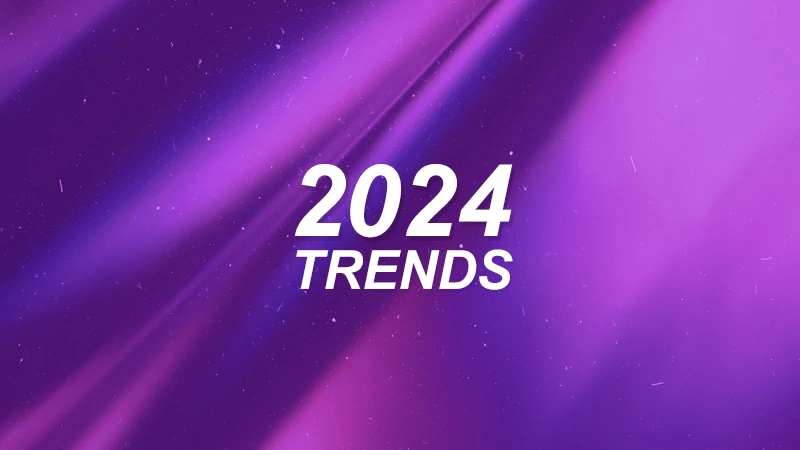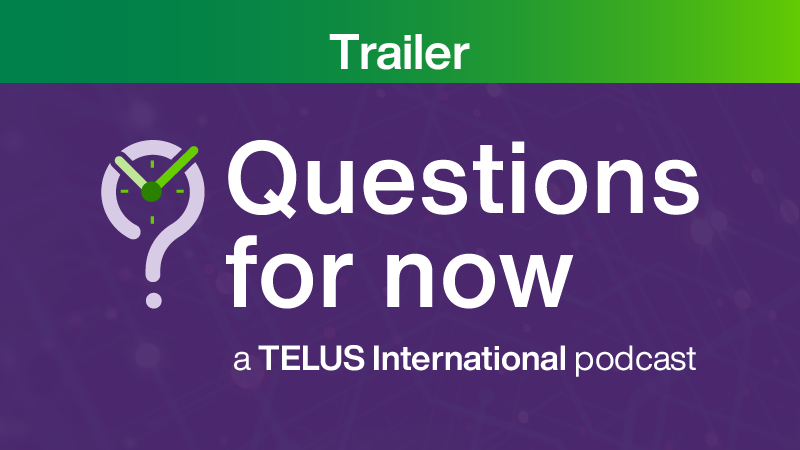- Insights
- Digital Experience
- Article
Five digital customer experience trends to consider for 2024

Trends tend to get a bad rap. Often they're seen as ephemeral and labeled as passing fads. "Wait it out," some will say, "a new trend will emerge soon enough."
There isn't necessarily something wrong with this point of view. Skepticism can be healthy. The pet rock has not yet made its big comeback.
That said, sometimes trends have real staying power, going on to change the way individuals and brands interact for years to come. The year's biggest trends in digital customer experience (CX), for example, have been a long time in the making and have every chance of creating a significant, lasting impression.
The five digital CX trends for 2024 that we're putting forth are informed by research and conversations conducted by Execs In The Know, in partnership with TELUS International, with leaders, including a survey of 117 customer experience executives across industries. These technologies and strategies are being talked about, and implemented, by some of the world's most successful brands. You'll want to consider these trends as you iterate upon your CX strategies and look to win customers and their trust.
Let's get into it.

Execs In The Know: 2024 CX Leaders Trends & Insights
Access the latest survey results and stay on top of customer experience (CX) developments in 2024 with this new report by Execs In The Know, sponsored by TELUS International.
1. Brands are doubling-down on data-driven CX
In an executive commentary written for the aforementioned survey from Execs In The Know, Kory Laszewski, vice president of global sales at TELUS International, puts the spotlight on data-driven CX as a trend for 2024. "There's no getting around it: Customer experience in the digital age is defined and driven by data," Laszewski asserts.
With the emergence of generative AI (GenAI), there is more and more attention paid to the data brands are collecting, the ways they are keeping it safe and how that data is being used to improve customer experiences. This puts the onus on brands to earn and maintain customer trust by following relevant data privacy laws and regulations and being transparent about data-related strategies and processes.
After earning customer trust, brands need to be strategic in the way they collect customer data. While 84% of respondents in the Execs In The Know report indicated that they use customer surveys to capture customer sentiment, these surveys can't be relied upon as the only source of this important data. In fact, response rates to direct feedback requests appear to be on the decline: According to a large Qualtrics survey of more than 28,000 consumers around the world, the percentage of consumers who submit direct feedback after a very bad experience has dropped by 7.2% since 2021. This trajectory suggests that brands may need to seek the data they need in other places. "Every customer touchpoint, across every channel your company leverages, is a source of essential feedback data," explains Laszewski. "Review customer support call logs, interactions between your customers and your chatbots, replies on your social media posts, and anywhere else your customers interact with your brand."
The next key step in embracing data-driven CX is to organize and operationalize your customer data. Annette Franz, founder and CEO of CX Journey Inc., shared insights on the matter on a recent episode of Questions for now, a TELUS International podcast, which focused on CX trends in 2024. "Data is at the heart of designing and delivering a great experience and data is what's going to be at the root of delivering that personalized experience," said Franz.
It is personalization that brands are striving for, but there are challenges that arise from the prevalence of legacy systems. Franz spoke to the difficulty, especially in larger organizations, that comes with meshing together disparate, legacy systems. And, for brands stifled by these challenges, there are consequences: Franz emphasized that without access to data "you can't personalize. You can't orchestrate the journey. You can't do all of these things with the data all over the place."
Annette Franz, founder and CEO of CX Journey Inc., speaking about customer centricity and data-driven CX on the Questions for now episode: "What trends are shaping customer experiences in 2024?"2. Customer experience leaders are equipping agents with GenAI
Perhaps unsurprisingly, year-over-year investment in AI-powered solutions is on the rise — 73% of the organizations that participated in the Execs In The Know survey are currently investing in AI in support of their CX operations, up from 48% in the previous year. But what is surprising is that "the investment balance has, for the first time, shifted toward agent-facing solutions." According to the report, this year, 60% of brands reported investing in agent-facing solutions, whereas 55% are investing in customer-facing solutions.
Brands that embrace the trend toward agent-facing AI could see a positive uptick in their most important metrics. In Forrester's Predictions 2024 report, the analyst firm argued that "CX will improve for the first time in three years" as a result of agent-facing GenAI that is capable of "answering questions faster and better, resolving problems on first contact, communicating clearly and leaving the customer feeling respected."
The applications and benefits abound. Agent-facing applications of generative AI are helping customer service professionals scrawl knowledge bases and documentation, assist with language translation, produce personalized responses and more. The technology only promises to get better, and the use cases broader, with the current pace of AI innovation.
Joining the same podcast episode as Annette Franz, Laszewski compared the future of agent-assist technology to J.A.R.V.I.S. from the Iron Man superhero franchise, depicted as an AI assistant capable of scanning the environment, surfacing contextually-relevant visuals and information and controlling interconnected hardware. In the context of digital CX, Laszewski imagines a future where customer service agents have similar assistants, meaning that "agents are going to have access to information significantly faster. They're going to be able to provide responses, proactive responses, using technology to help augment the decisions that they're making real-time throughout a call." Like the fictional version, such an assistant would monitor conversations between customers and agents, offering agents examples or advice, and pulling client data and information to be able to provide an ideal response, Laszewski went on to explain.
3. Customer-facing applications of GenAI are growing in prevalence
Forrester predicts that "half of large global firms will experiment with customer-facing GenAI," per the aforementioned report.
Ready or not, here it comes. There is a sense that brands feel the need to roll out something to their customers that makes use of generative AI in order to keep pace with their competitors and the expectations of their customers. In fact, Execs In The Know suggested brands that have not yet implemented GenAI "will be at a competitive disadvantage."
An Everest Group survey, supported by TELUS International, polled 200 CX leaders to determine their enterprise readiness for the adoption of generative AI. Consider these findings:
- 55% of organizations planned on spending at least $1 million on generative AI for CX over the next 12-18 months (as of the beginning of the year)
- 46% of organizations reported piloting or deploying GenAI for text generation in CX, with 21% already scaling up their implementations
- 47% of organizations planned to pilot or deploy GenAI solutions in their customer support operations for non-voice channels in the next 6-12 months (as of the beginning of the year)
- 19% of organizations stated that CX applications of GenAI have potential for "significant impact" when it comes to improving customer satisfaction (CSAT)
These findings paint a clear picture: Brands are moving ahead with customer-facing applications of GenAI and customers can expect to have more interactions with the technology when reaching out for support.
The list of applications lengthens all the time, but notable examples include: better chatbots that are capable of providing accurate, personalized responses around the clock; improved call routing and prioritization, which means customers get connected to a suitable agent for their needs; and voice-enabled assistants that understand countless languages and can not only respond to, but also act on, customer requests.
4. Brands are seeking to understand preferences to facilitate right channeling
Interestingly, the Execs In The Know survey revealed that for the second consecutive year "there was less certainty among CX leaders about whether their companies have a good understanding of which channels their customers prefer to use."
There could be a number of reasons for this uncertainty, including evolving customer behaviors, a proliferation of channels and internal misalignment. With the growing influence of generative AI and the increased focus on customer data however, technology has the potential to bridge gaps in CX leaders' understanding. Now, more than ever, brands are better equipped to draw out precise insights about customer preferences. This understanding facilitates right channeling, our fourth trend for 2024.
To explain right channeling, it makes sense to begin with a term that has been on the minds of customer experience leaders for years: omnichannel CX. With an omnichannel approach to customer experience, all of a brand's channels are integrated to provide a consistent, cohesive and low-effort experience for customers. As a customer moves across your channels, perhaps from your app, to your website, to your chatbot, to speaking with one of your agents on the phone, omnichannel CX retains context and personalizes service, saving the customer from having to repeat themselves.
Right channeling builds on omnichannel CX and has a similar purpose in delivering low effort customer experiences. With right channeling, the goal is for the brand to identify and direct the customer to the ideal channel, in terms of efficiency and effectiveness, for each type of customer interaction. If a customer is looking for ways to get the most out of your product, right channeling might direct them to use cases on your website. In contrast, if a customer is experiencing technical difficulties with their account, they might get routed directly to a customer service agent. This approach is only possible with a deep understanding of customer preferences and your channels.
5. Brands are expecting more from the CX outsourcing providers
Today, brands who outsource aspects of the customer experience expect their providers to bring more to the table.
In his podcast appearance, Laszewski explained that business leaders want to see more from providers than the ability to run an effective contact center. Instead, these leaders are asking: "What other services can you provide? What other value can you deliver outside of running a really good call center operation? What kind of data can you deliver back to me in terms of the interactions that your teams are handling? What kind of transformation [or] digital consultancy services can you provide for me that can help me guide my path in terms of strategy on the deployment of various technologies?"
This same idea can be seen in the Everest Group survey about enterprise readiness for the adoption of generative AI, which found that 76% of respondents are planning to leverage an outsourcing partnership in some capacity to help them implement a generative AI solution in their CX operations.
As a result of these heightened expectations, top providers will rise to the challenge, leveraging their access to technology, expertise and global scale to co-innovate with brands across industries. For example, at TELUS International, we've deployed robotic process automation (RPA) to streamline sales order processing for a frozen food company, assembled a sophisticated cloud infrastructure for a successful telecom and met complex data annotation requirements of a unique non-profit organization.
The expectation for innovation isn't going away and so it is up to providers to adapt. In the context of GenAI, for example, TELUS International helps brands put generative AI applications into production faster using flexible solutions for development, deployment, testing and management, all through our enterprise-grade AI engine, Fuel iX.
Trend in the right direction with a proficient partner
If you’re looking for a partner that can help you innovate and keep pace with, or even get ahead of, the most important CX trends, you've come to the right place. TELUS International partners with over 650 global and disruptive brands across industries to design, build and deliver incisive solutions that meet and exceed customer expectations. Contact our team of experts to get started.




